Human Identification Through Gum-A New Vision In Forensic Odontology
Arushi Chawla1*, Dhwani Patel2, Ashwini Pandit3
1 Assistant Professor (Forensic Science and Forensic Odontology), Institute of Applied Sciences, Parul University, Vadodara, Gujarat.
2Assistant Professor (Forensic Odontology), Institute of Forensic Science, Gujarat Forensic Sciences University, Gandhinagar.
3 Assistant Professor (MBA-Hospital & Healthcare Management), Institute of Management & Training, Gujarat Forensic Sciences University, Gandhinagar.
|
|
Introduction
The presence of periodontal diseases is considered as a significant cause affecting the oral hygiene negatively 1. Dental implant acts as the common dental procedure that is usually undertaken during the cases of jaw or mouth Injuries 2. The benefits of the chewing gum are known to the layman as to increase the power of concentration in humans, a sudden grant of sugars in the metabolic system3. The chewing gum can decrease the pH if it contains citric acid or via bacterial production of acids if the gum contains sugars. The average rate of salivary flow in a completely healthy individual is 0.3-0.4 mL/min4. The chewing of an unflavored gum increases the salivary flow by 10-12 times when compared to non-stimulated rate5. As the chewing gum increases the rate of salivary flow it also assists in the clearance of acid in the esophagus and hence helps in reducing the gastroesophageal reflux conditions.6,7 and laryngopharyngeal reflux conditions8. Chewing is also known to treat xerostomia in those with residual secretory capacity9
The non-metric traits are the structural variations of individual crown and root which can be individually scored10. The tooth consists of three distinct layers; the enamel which covers the crown, the root cementum on the root surface, and an inner layer of dentin in the crown and the root 11. When using conventional dental materials, the recording of non-metric dental traits becomes difficult. These non-metric.
traits play a very important role in the process of identification. There have been cases where chewing has proved to be a piece of important evidence at the crime scene. The technique to be used can make the process of investigation and record conveniently to be used by dentists and forensic officers. The dental materials used in conventional dentistry are technique sensitive, expensive, and can cause infections due to cross-contamination. This technique promotes ease of use, inexpensive, and has the least chances of infection by cross-contamination. The materials used in the study are commercially available and also fall in the economical norms. This technique has proved to be useful in cases of severe malocclusion, allergies to some dental products, in case of any oral pathology.
Materials and Method
The materials used in the study are easily available in the market and are economical to be used.
The materials used are
Method
The subject was informed verbally about the technique to be performed to reduce dental anxiety. A commercially available gum was used and manipulated using a solution containing saliva substitute. The manipulation was done for 4 to 5 minutes and was heated slightly. In the meanwhile, the area to be recorded was cleaned. As the impression mix was bought down to room temperature, the impression material was placed in the mouth when a rubbery consistency was achieved. Blowing in would allow the gum to be dried and then the impression was removed from the mouth. A photograph of the impression was taken to record and preserve the trace shreds of evidence.

Figure 1: Demonstrates the subject with severe malocclusion

Figure 2: Demonstrates the impression when placed in the oral cavity for

Figure 3: Demonstrates the impression taken with labially placed teeth
The following method was used in different cases as mentioned below
Results
Various other impressions were taken using gum and solutions. Various non-metric traits like Talon’s cusp, Cusp of Carabelli, Cuspal indentation. Figures 4, 5, and 6 demonstrate the result respectively. In cases of severe malocclusion, spacing, the method has proved to record the areas that are not easily accessible by conventional dental techniques as seen in figure 7 a/b and 8. To study the rugae patterns, the palatal rugae were easily recorded by this technique which is demonstrated in figure 9. The tongue prints that are unique for every individual can also be recorded using this technique as shown in figure 10. The technique has been advantageous when used in cases of xerostomia as the solution used increases the salivary secretion. In case of severe gagging the technique to use proved to be useful as based on the Gagging Problem Assessment- Revised (GPA-R).
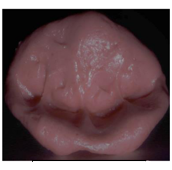
Figure 4: Talon’s Cusp
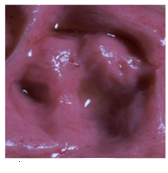
Figure 5: Molar cusps
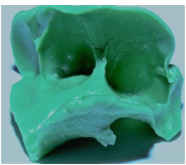
Figure 6: Canine Indentation
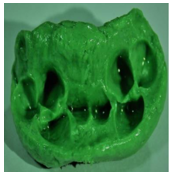
Figure 7a: Impression of severe
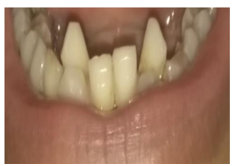
Figure 7b: Severe malocclusion
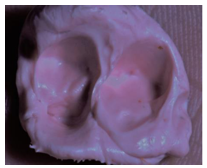
Figure 8: Spacing Seen The Lateral Incisor And Canine.
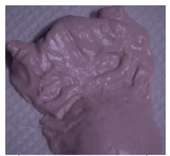
Figure 9: Rugae Patterns
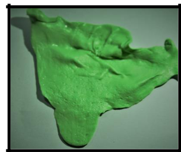
Figure 10: Tongue Prints
Discussion:
The advantages of the gumming technique are that it is economical and pocket friendly. The technique has a conservative approach and the wastage of the material can be avoided. The technique requires no specialization and is user-friendly when compared to other dental materials like alginate12,13. The patient is psychologically satisfied with an easier way of recording the anatomy as the use of more instruments and materials are known to affect the mental health of some patients14. The record-keeping becomes easier and casts can be poured using polyvinyl if a permanent record is required3. The material shows negligible shrinkage with naked eyes when compared to other dental products where the casts are to be poured immediately15.
The technique is easy to use in case of an oral pathology like a fibroma on the tongue or in cases of painful ulcerations. Recording anatomy with this technique is easier in patients with xerostomia5. This technique can be used in cases of mobility (grade 1). Immense infection control is not required in this technique when compared to dental materials 15. The drawbacks of the technique are that the chewing gum becomes sticky on removal and there are high chances of swallowing the gum when taking impressions. The technique cannot be used in edentulous patients16. The forensic implication of the technique including the above-mentioned advantages are that impressions can be recorded immediately and the loss of trace shreds of evidence can be prevented. The technique can also be used in cases of sexual assault when the suspect’s dentition is to be compared to the bitemark present on the victim.
Conclusion:
This technique is an attempt to ease the tedious process of criminal investigation and introduce new material to overcome the drawbacks of the materials used in conventional dentistry. This technique can help to record the offender’s dentition with ease and fast-track the sexual assault cases in various countries of the world where the cases are delayed due to a lack of resources and a high crime rate. The technique shall prove to be useful when in remote areas or where the dental materials or a forensic odontologist is not readily available. Hence chewing gum is probably a kind of food material that shall prove to provide excellent results when recording the morphological features of the dentition and also provide additional information about the same.
References
Corresponding Author
Dr. Arushi Chawla
Assistant Professor, Department of Forensic Science, PIAS, Parul University
Email: arushi.chawla82130 @ paruluniversity.ac.in